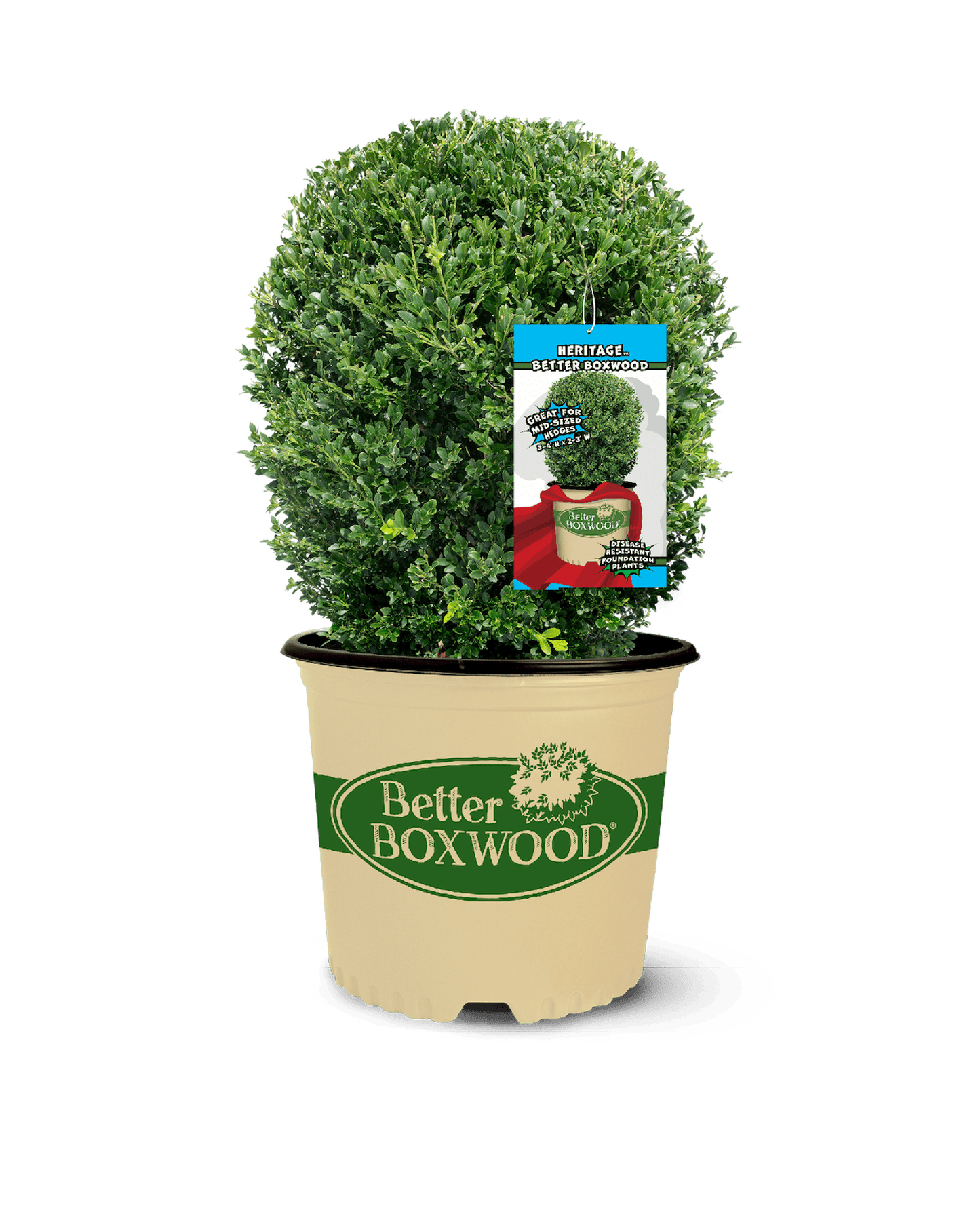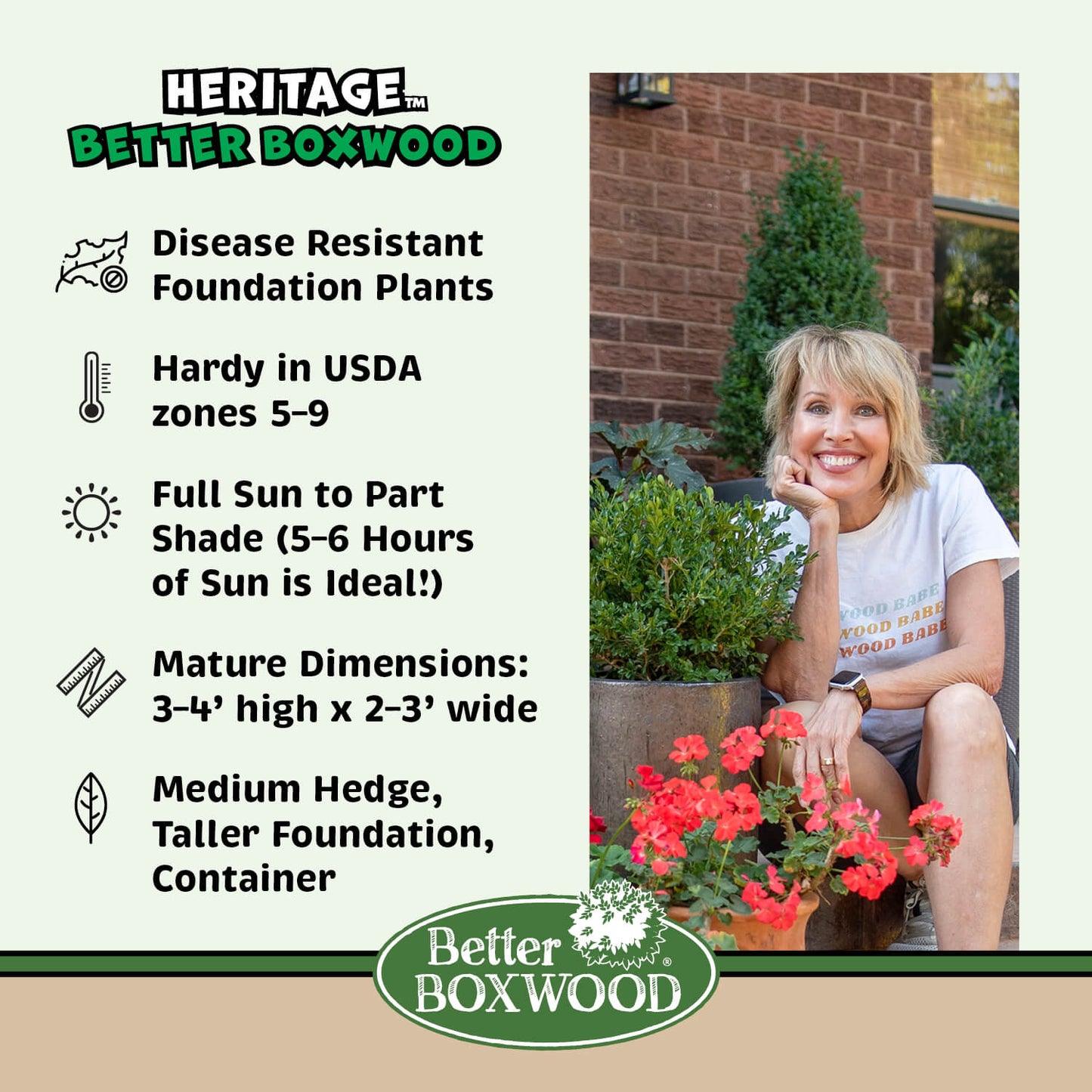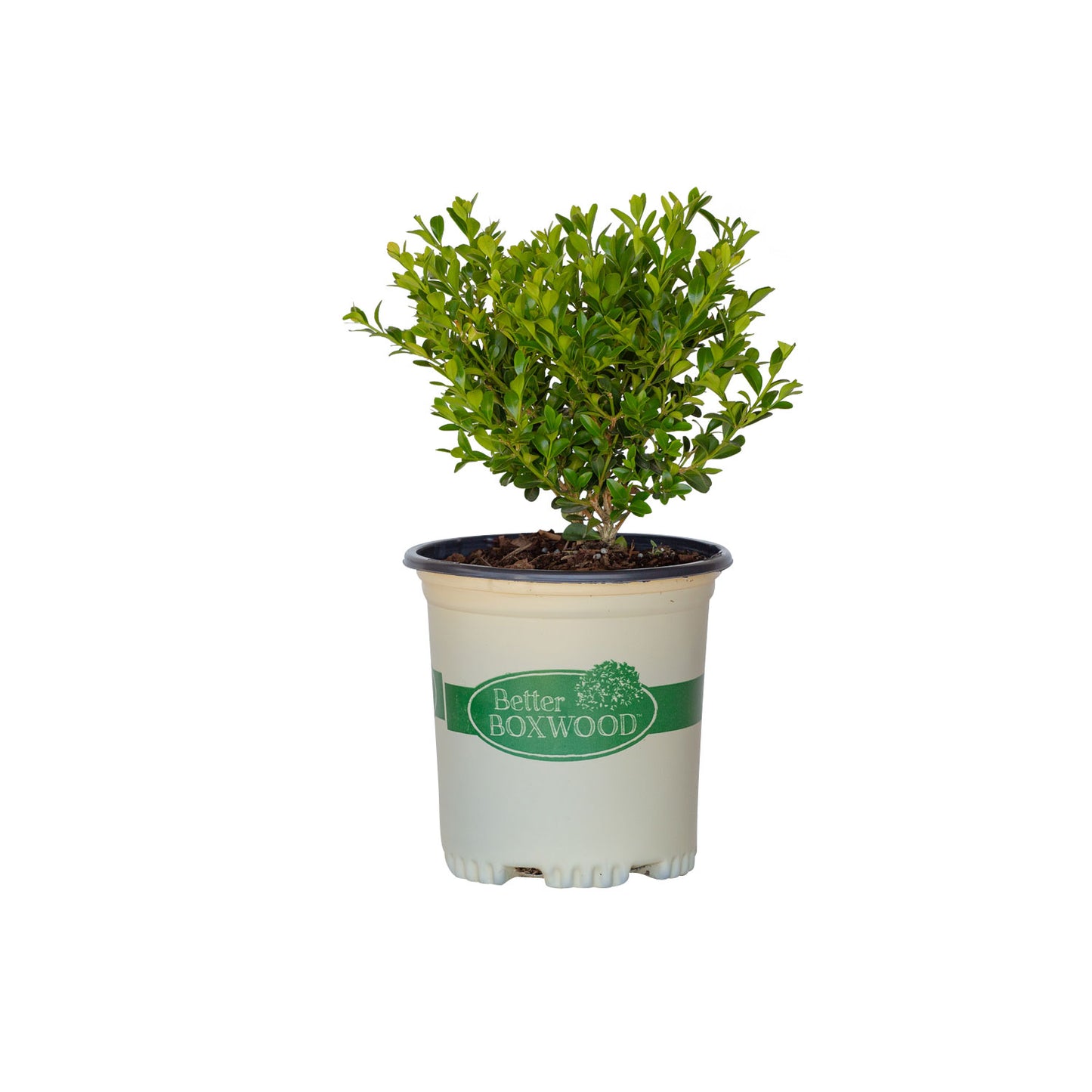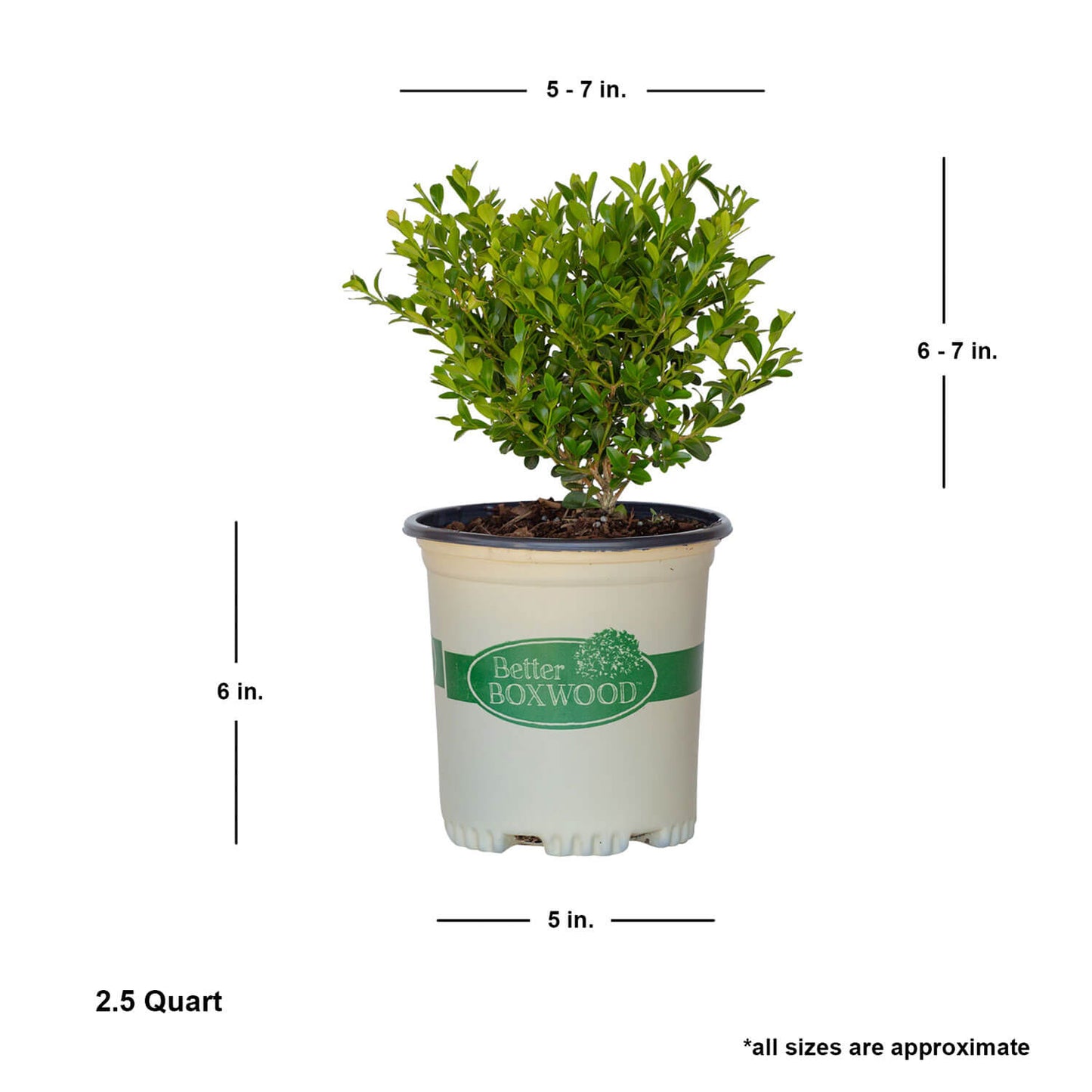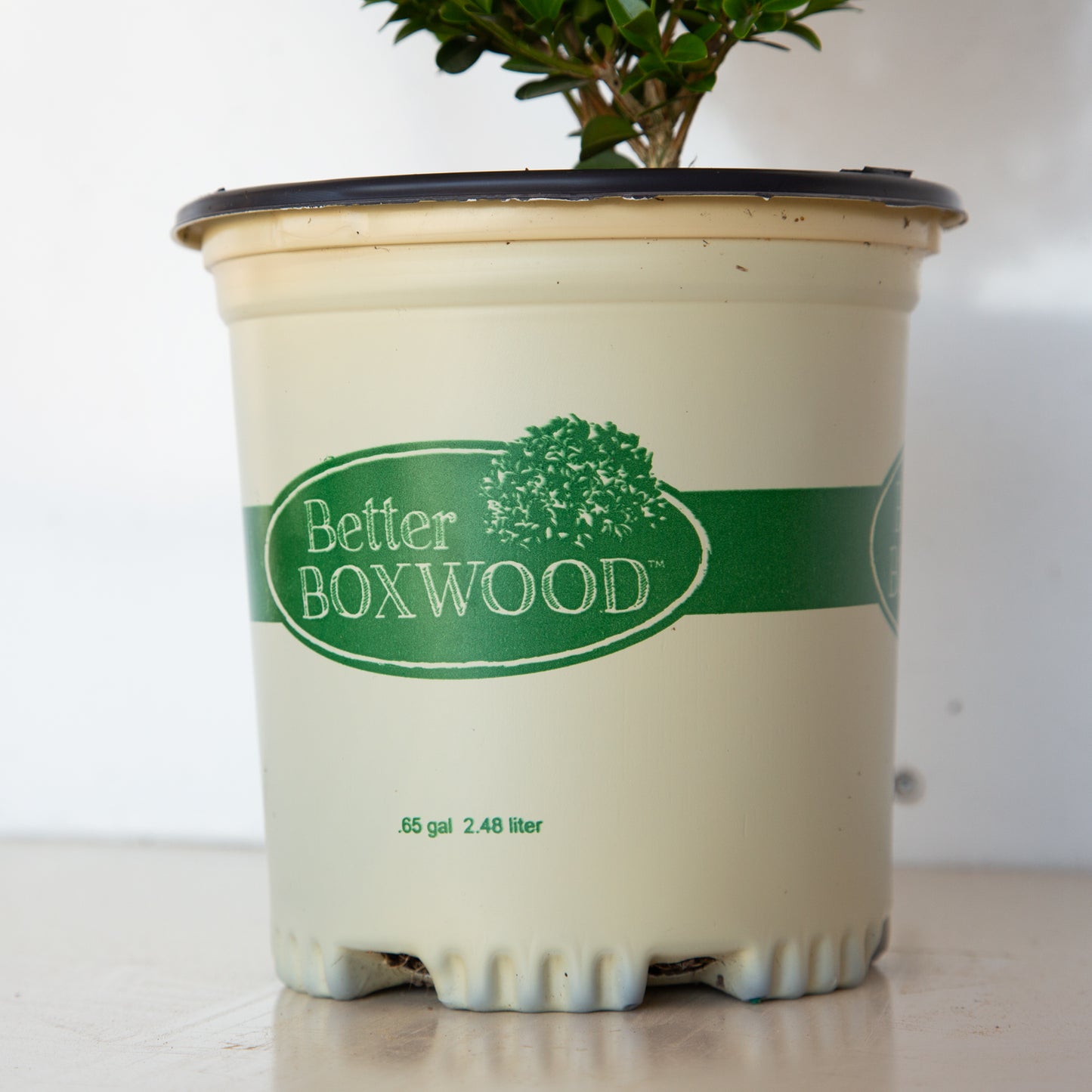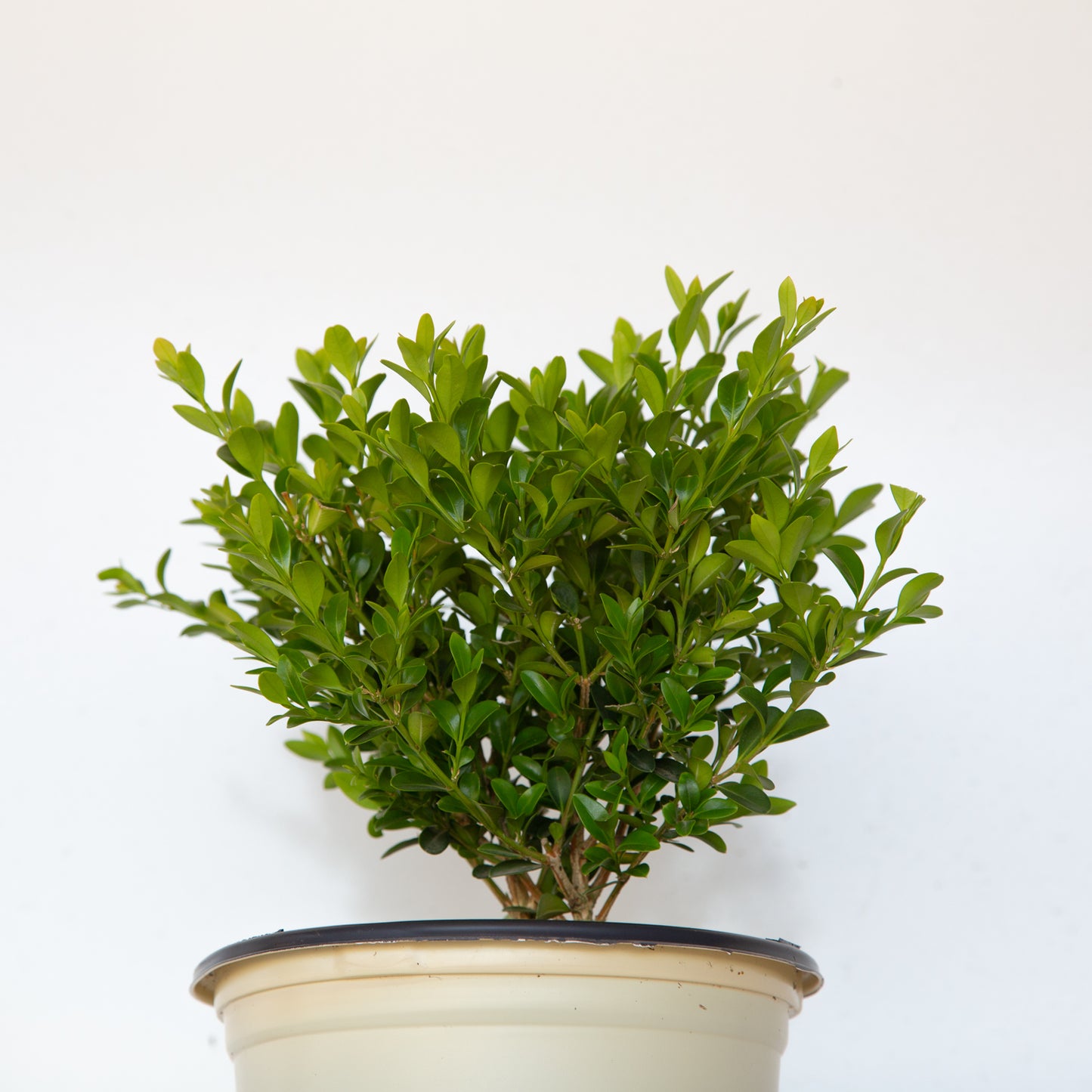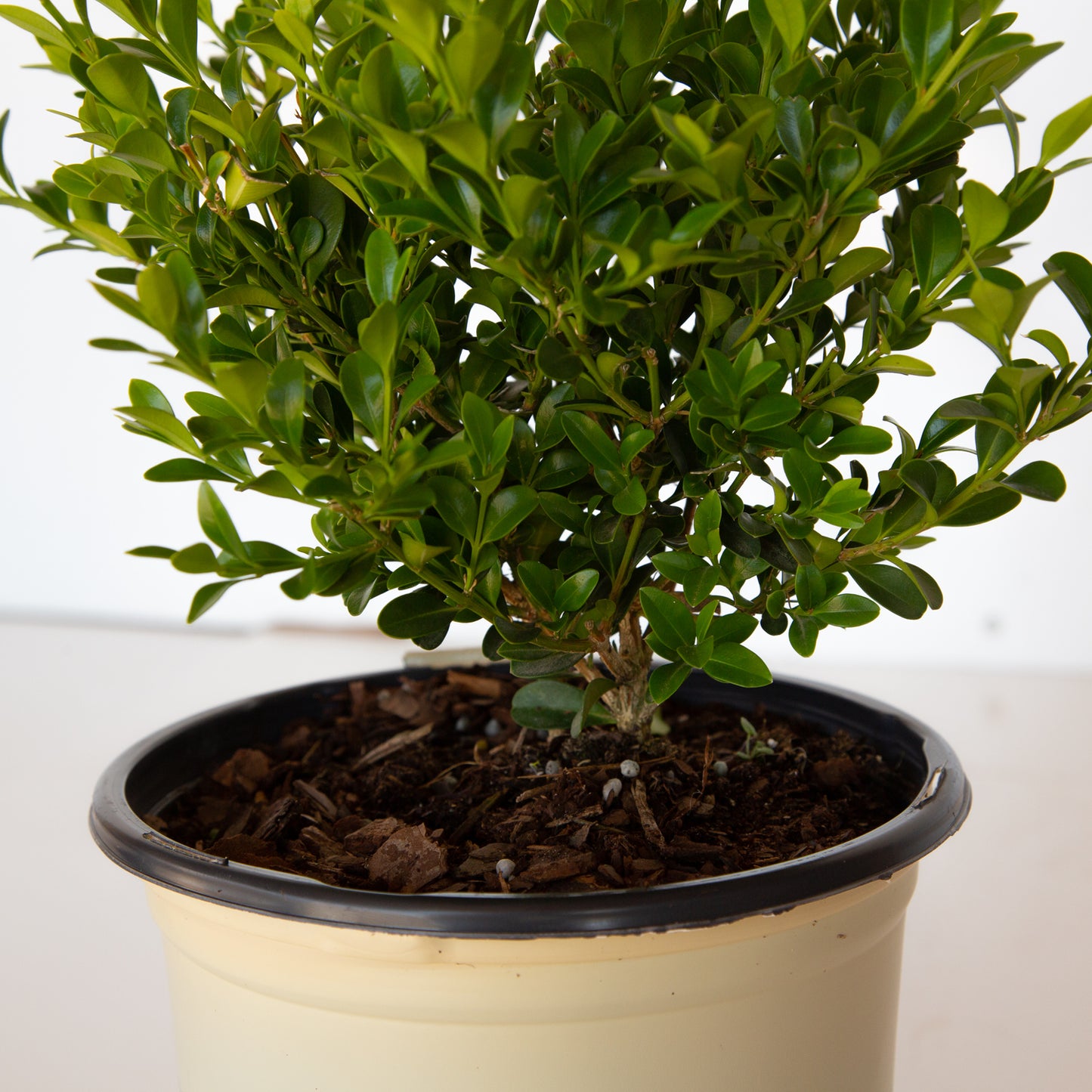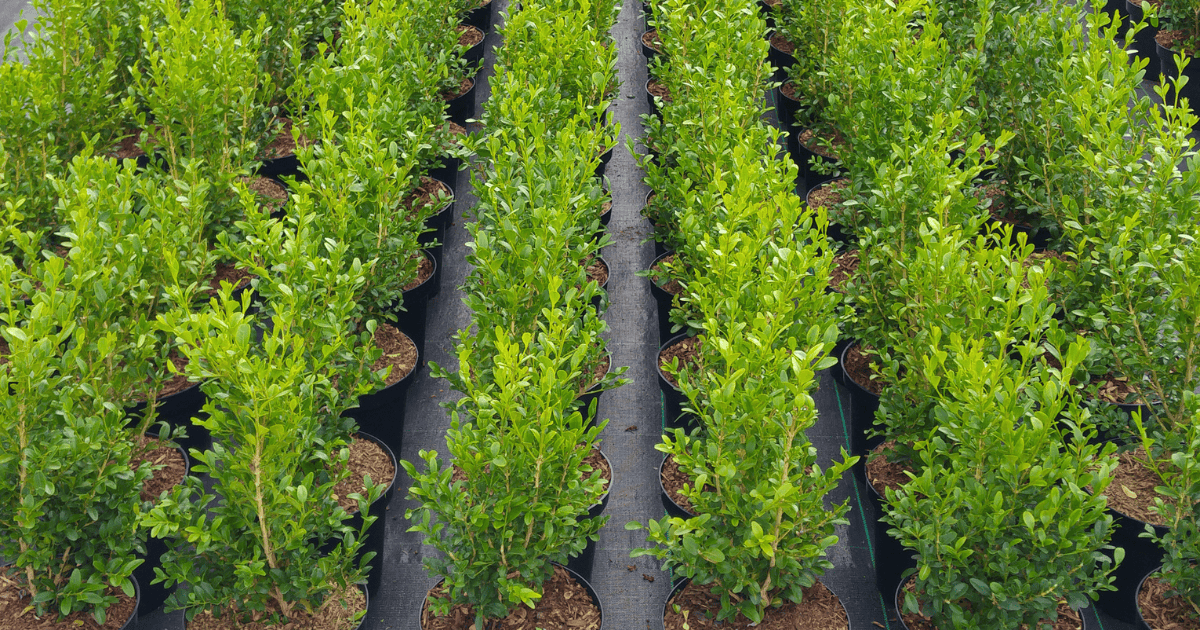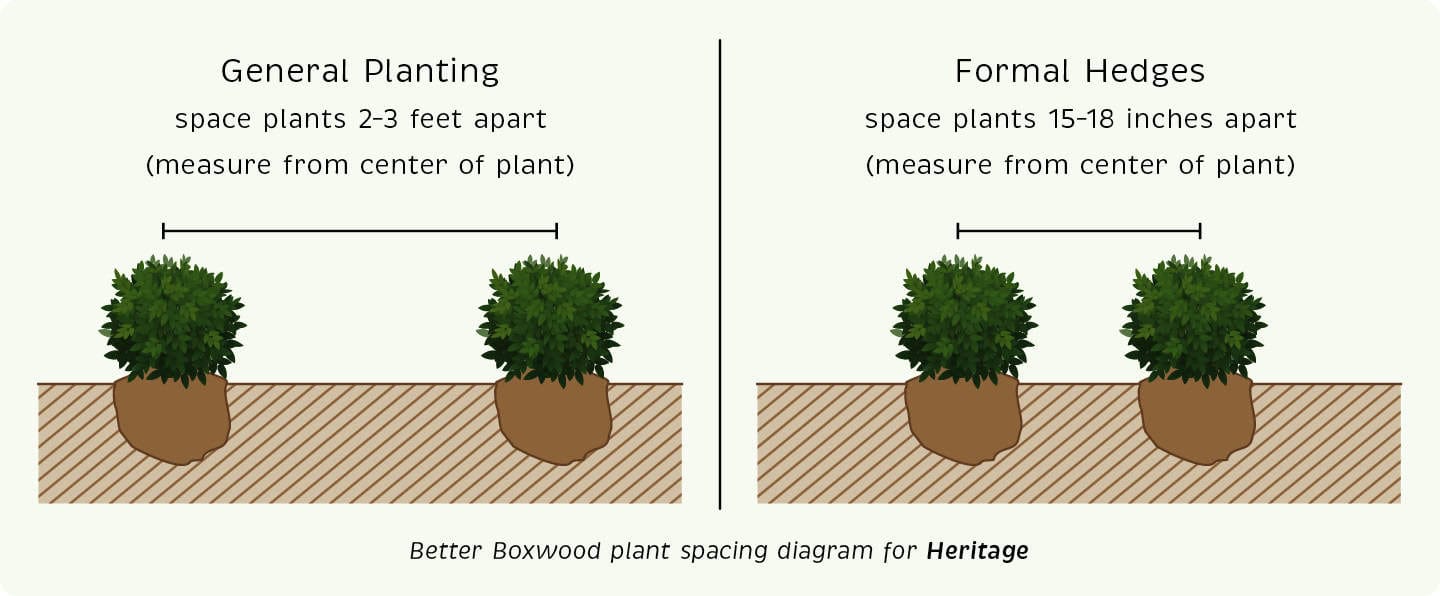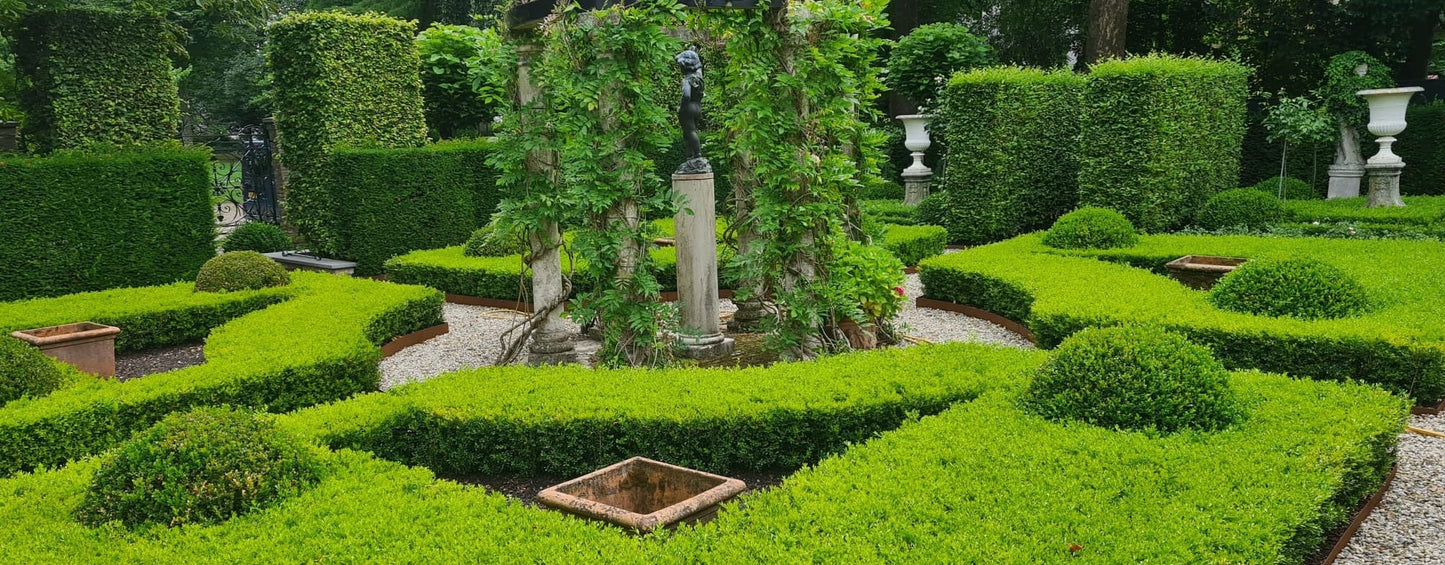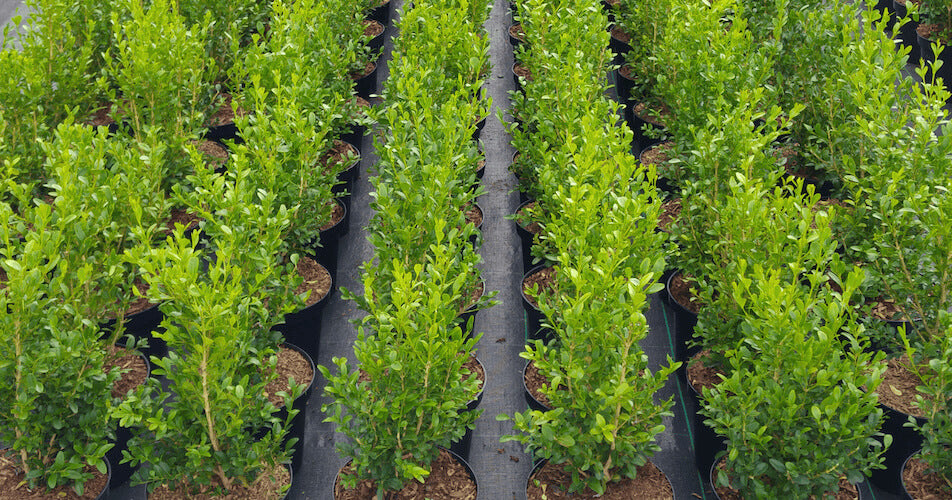
Heritage™
Buxus Hybrid ‘HER2010B02' PP32309
Heritage Boxwood boasts dense, deep green foliage that enhances any garden setting. Its traditional boxwood habit, combined with a more compact size (growing to 3-4' H x 2-3' W), makes it ideal for creating low hedges that beautifully frame pathways or entrances. Heritage’s symmetry and adaptability also make it an excellent choice for topiary designs, adding a touch of structure to your landscape. Perfect for use as a hedge, on taller foundations, or in containers, and it responds well to pruning into various shapes. Sustainably bred for disease resistance, Heritage ensures a lush, vibrant appearance with minimal maintenance.
Heritage Boxwood boasts dense, deep green foliage that enhances any garden setting. Its traditional boxwood habit, combined with a more compact size (growing to 3-4' H x 2-3' W), makes it ideal for creating low hedges that beautifully frame pathways or entrances. Heritage’s symmetry and adaptability also make it an excellent choice for topiary designs, adding a touch of structure to your landscape. Perfect for use as a hedge, on taller foundations, or in containers, and it responds well to pruning into various shapes. Sustainably bred for disease resistance, Heritage ensures a lush, vibrant appearance with minimal maintenance.
We do our best to provide the highest-quality plants. To ensure your plants do well in transit, please be aware of your area’s weather conditions when placing your order. We strive to ship all orders within 24-48 hours. We do not ship on Sundays, so orders placed on Saturday or Sunday will ship on the next business day.
We ship to the continental United States except for Tennessee.
We do our best to provide the highest-quality plants. To ensure your plants do well in transit, please be aware of your area’s weather conditions when placing your order. We strive to ship all orders within 24-48 hours. We do not ship on Sundays, so orders placed on Saturday or Sunday will ship on the next business day.
We ship to the continental United States except for Tennessee.
Heritage Boxwood boasts dense, deep green foliage that enhances any garden setting. Its traditional boxwood habit, combined with a more compact size (growing to 3-4' H x 2-3' W), makes it ideal for creating low hedges that beautifully frame pathways or entrances. Heritage’s symmetry and adaptability also make it an excellent choice for topiary designs, adding a touch of structure to your landscape. Perfect for use as a hedge, on taller foundations, or in containers, and it responds well to pruning into various shapes. Sustainably bred for disease resistance, Heritage ensures a lush, vibrant appearance with minimal maintenance.
Heritage Boxwood boasts dense, deep green foliage that enhances any garden setting. Its traditional boxwood habit, combined with a more compact size (growing to 3-4' H x 2-3' W), makes it ideal for creating low hedges that beautifully frame pathways or entrances. Heritage’s symmetry and adaptability also make it an excellent choice for topiary designs, adding a touch of structure to your landscape. Perfect for use as a hedge, on taller foundations, or in containers, and it responds well to pruning into various shapes. Sustainably bred for disease resistance, Heritage ensures a lush, vibrant appearance with minimal maintenance.
We do our best to provide the highest-quality plants. To ensure your plants do well in transit, please be aware of your area’s weather conditions when placing your order. We strive to ship all orders within 24-48 hours. We do not ship on Sundays, so orders placed on Saturday or Sunday will ship on the next business day.
We ship to the continental United States except for Tennessee.
We do our best to provide the highest-quality plants. To ensure your plants do well in transit, please be aware of your area’s weather conditions when placing your order. We strive to ship all orders within 24-48 hours. We do not ship on Sundays, so orders placed on Saturday or Sunday will ship on the next business day.
We ship to the continental United States except for Tennessee.
Versatile Mass Planting
Growth Habit
Best Uses
Maintenance
Planting Care tips for Heritage™
- Heritage™ boxwoods grow best in USDA zones 5-9 and prefer soils that are well-drained. While they can adapt to various soil types—acidic, alkaline, clay, or sandy—good drainage is important to avoid root rot.
- These shrubs do well in partial shade to dappled sunlight but can tolerate full sun. In hotter climates, afternoon shade helps prevent heat stress. Heritage™ grows best with 4-6 hours of morning sunlight, but in heavily shaded areas, it may become less dense.
- For colder regions, planting in a protected location can help shield the plant from harsh winter winds.
- When planting Heritage™ boxwoods, space them 3-4 feet apart to allow for full growth, as they typically reach 4-5 feet in height and spread to about 3-4 feet wide.
- Heritage™ boxwoods grow best in USDA zones 5-9 and prefer soils that are well-drained. While they can adapt to various soil types—acidic, alkaline, clay, or sandy—good drainage is important to avoid root rot.
- These shrubs do well in partial shade to dappled sunlight but can tolerate full sun. In hotter climates, afternoon shade helps prevent heat stress. Heritage™ grows best with 4-6 hours of morning sunlight, but in heavily shaded areas, it may become less dense.
- For colder regions, planting in a protected location can help shield the plant from harsh winter winds.
- When planting Heritage™ boxwoods, space them 3-4 feet apart to allow for full growth, as they typically reach 4-5 feet in height and spread to about 3-4 feet wide.
- Start by preparing well-drained soil, as boxwoods are susceptible to root rot if waterlogged. Amend the soil with organic matter like compost to improve its structure, especially in clay or sandy soils.
- Dig a hole twice the width of the root ball and as deep as the plant’s root system. This allows the roots to spread out comfortably. If the plant is root-bound, gently loosen the roots before planting to encourage better growth.
- Start by preparing well-drained soil, as boxwoods are susceptible to root rot if waterlogged. Amend the soil with organic matter like compost to improve its structure, especially in clay or sandy soils.
- Dig a hole twice the width of the root ball and as deep as the plant’s root system. This allows the roots to spread out comfortably. If the plant is root-bound, gently loosen the roots before planting to encourage better growth.
- Position the shrub so that the top of the root ball is level with or slightly higher than the surrounding soil. This prevents the plant from sitting too low, which can lead to water pooling around the base.
- Once positioned, backfill the hole with soil, firming it down gently. Water thoroughly after planting to help settle the soil and eliminate any air pockets around the roots. Avoid over-compacting the soil.
- Apply a 2-3 inch layer of organic mulch, such as shredded bark or compost, around the base of the plant to help retain moisture, suppress weeds, and regulate soil temperature. Be sure to leave a small gap between the mulch and the stem to avoid rot.
- Position the shrub so that the top of the root ball is level with or slightly higher than the surrounding soil. This prevents the plant from sitting too low, which can lead to water pooling around the base.
- Once positioned, backfill the hole with soil, firming it down gently. Water thoroughly after planting to help settle the soil and eliminate any air pockets around the roots. Avoid over-compacting the soil.
- Apply a 2-3 inch layer of organic mulch, such as shredded bark or compost, around the base of the plant to help retain moisture, suppress weeds, and regulate soil temperature. Be sure to leave a small gap between the mulch and the stem to avoid rot.
- In its first year, regular watering is essential to help the roots establish. Water deeply once a week, and increase the frequency in hot or dry weather. After the first year, reduce watering to maintain evenly moist soil, but avoid overwatering.
- In early spring, apply a slow-release, balanced fertilizer to encourage healthy growth. Over-fertilization can result in excessive, weak growth, which may make the plant more vulnerable to disease.
- In its first year, regular watering is essential to help the roots establish. Water deeply once a week, and increase the frequency in hot or dry weather. After the first year, reduce watering to maintain evenly moist soil, but avoid overwatering.
- In early spring, apply a slow-release, balanced fertilizer to encourage healthy growth. Over-fertilization can result in excessive, weak growth, which may make the plant more vulnerable to disease.
- Heritage™ boxwoods are naturally dense and compact, so they require minimal pruning. However, if you wish to shape them, light pruning in late winter or early spring will promote thicker growth and a more uniform appearance. This variety is known for its resistance to boxwood blight and pests, making it an easy-care option for gardeners.
- Heritage™ boxwoods are naturally dense and compact, so they require minimal pruning. However, if you wish to shape them, light pruning in late winter or early spring will promote thicker growth and a more uniform appearance. This variety is known for its resistance to boxwood blight and pests, making it an easy-care option for gardeners.
- In colder climates, boxwoods may experience winter damage due to exposure to cold winds and fluctuating temperatures. Protect the roots by applying mulch around the base before winter. In more severe climates, wrapping the plant in burlap can offer additional protection from harsh winds and freezing temperatures.
- By choosing the right location, providing proper care, and protecting the plant during winter, you can enjoy the beauty of this disease-resistant boxwood for years to come.
- In colder climates, boxwoods may experience winter damage due to exposure to cold winds and fluctuating temperatures. Protect the roots by applying mulch around the base before winter. In more severe climates, wrapping the plant in burlap can offer additional protection from harsh winds and freezing temperatures.
- By choosing the right location, providing proper care, and protecting the plant during winter, you can enjoy the beauty of this disease-resistant boxwood for years to come.

Where to Buy
Want to buy Better Boxwood from a local garden center or retail location? Use our store finder for the location closest to you.

